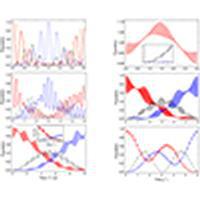当前位置:
X-MOL 学术
›
J. Opt. Soc. Amer. B
›
论文详情
Our official English website, www.x-mol.net, welcomes your
feedback! (Note: you will need to create a separate account there.)
Non-resonant interactions and multipartite entanglement in a system of coupled cavities
Journal of the Optical Society of America B ( IF 1.8 ) Pub Date : 2020-03-05 , DOI: 10.1364/josab.381215 Fazal Badshah , Guo-Qin Ge , Mauro Paternostro , Shahid Qamar
Journal of the Optical Society of America B ( IF 1.8 ) Pub Date : 2020-03-05 , DOI: 10.1364/josab.381215 Fazal Badshah , Guo-Qin Ge , Mauro Paternostro , Shahid Qamar

|
We study quantum state transfer and multipartite entanglement generation in the ensembles of qubits enclosed by a one-dimensional system of coupled optical cavities. Each cavity contains $ N $ qubits whose interaction with the quantum field of their respective cavity is governed by the Dicke Lipkin–Meshkov–Glick model. An excitation initially seeded in the ensemble at the end of the one-dimensional chain of coupled cavities transfers to the corresponding ensemble of the last cavity with success that depends on the mode-ensemble coupling $ \chi $, ensemble-mode detuning $ \delta $, photon hopping rate $ \lambda $, and size of a given ensemble $ N $. Suitable choices of such parameters enable overcoming the freezing effect induced by the choice of a far-off detuning regime. We identify working points at which three-ensemble $ W $ states and two-ensemble maximally entangled states emerge in the multipartite entanglement dynamics. This study provides a basis for manipulation of quantum states in a multipartite coupled cavity arrangement that may be useful in understanding very complex systems in the field of quantum information processing.
中文翻译:

耦合腔系统中的非共振相互作用和多部分纠缠
我们研究耦合光腔的一维系统所包围的量子比特群中的量子态转移和多方纠缠生成。每个腔包含$ N $个量子位,它们与各自腔的量子场的相互作用由Dicke Lipkin–Meshkov–Glick模型控制。最初在耦合腔的一维链的末尾播种在集成体中的激励,成功转移到最后一个腔体的相应集成体,其成功取决于模式-集成体耦合$ \ chi $,集成模式失谐$ \ delta $,光子跳跃率$ \ lambda $和给定集合的大小$ N $。这样的参数的合适选择,使得能够克服由一个遥远的失谐制度的选择所引起的冷冻效果。我们确定了在多粒子纠缠动力学中出现三个整体$ W $状态和两个整体最大纠缠状态的工作点。这项研究为操纵多部分耦合腔体排列中的量子态提供了基础,这可能有助于理解量子信息处理领域中非常复杂的系统。
更新日期:2020-03-05
中文翻译:

耦合腔系统中的非共振相互作用和多部分纠缠
我们研究耦合光腔的一维系统所包围的量子比特群中的量子态转移和多方纠缠生成。每个腔包含$ N $个量子位,它们与各自腔的量子场的相互作用由Dicke Lipkin–Meshkov–Glick模型控制。最初在耦合腔的一维链的末尾播种在集成体中的激励,成功转移到最后一个腔体的相应集成体,其成功取决于模式-集成体耦合$ \ chi $,集成模式失谐$ \ delta $,光子跳跃率$ \ lambda $和给定集合的大小$ N $。这样的参数的合适选择,使得能够克服由一个遥远的失谐制度的选择所引起的冷冻效果。我们确定了在多粒子纠缠动力学中出现三个整体$ W $状态和两个整体最大纠缠状态的工作点。这项研究为操纵多部分耦合腔体排列中的量子态提供了基础,这可能有助于理解量子信息处理领域中非常复杂的系统。











































 京公网安备 11010802027423号
京公网安备 11010802027423号